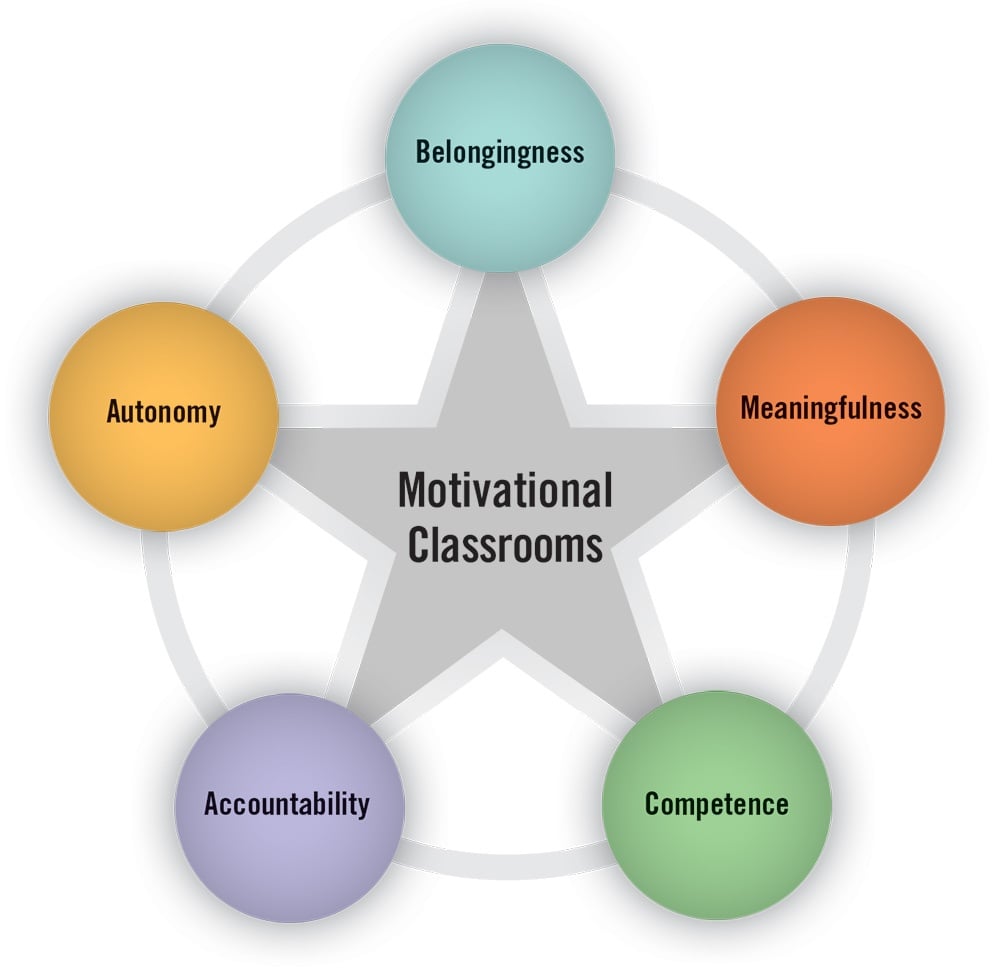
In her groundbreaking book, Motivated, author Ilana Seidel Horn outlines the features of a motivational classroom. Based on her research, Horn has found that a motivational classroom attends to the following five features...
- students’ sense of belongingness
- the meaningfulness of learning
- students’ competence
- structures for accountability
- students’ autonomy
Teachers can foster all of these through deliberate instructional design as they tinker to motivate their students. Here's where to start:
BELONGINGNESS refers to people’s innate need to establish close relationships with others. Students who slink down into their desks, doing everything physically possible to make themselves disappear, communicate with their body language that they do not feel like they belong. In contrast, when students experience frequent, pleasant interactions with others or feel that those around them are concerned for their well-being, they feel like they belong. Teachers can foster a sense of belongingness by encouraging and modeling an environment of mutual respect.
MEANINGFULLNESS involves developing an interest in or appreciation for academic content. Every math teacher gets asked the same question at one point or another: When are we ever going to use this? Instead of viewing this question as students’ resistance or reluctance to learn, we should understand that they are often searching for meaningfulness. Teachers can cultivate meaningful learning by building on students’ prior knowledge and experiences, providing access to complex ideas and extended exploration.
COMPETENCE describes the need to be successful in meeting goals and interacting with the environment. By the time students arrive in our classrooms, they have often had many experiences feeling incompetent in mathematics. Because school math commonly values two primary forms of mathematical competence— quickness and accuracy—students have seldom had a chance to recognize their own mathematical strengths. Teachers can increase students’ sense of competence by providing appropriately challenging tasks, giving formative feedback, and helping students recognize their own mathematical strengths. Teachers can also increase students’ sense of competence by normalizing mistakes as opportunities to grow and learn. This fosters effort and persistence.
ACCOUNTABILITY refers to the structures and routines that oblige students to report, explain, or justify their activities. Often reduced simply to assessment, accountability goes beyond how we grade to encompass the routines and norms that enjoin students to participate in particular ways in classroom life. When students feel a sense of investment in and accountability to their classmates, for example, this changes the risk-benefit calculus, leveraging positive peer pressure to increase participation. Likewise, if students have some say in their activities or understand the relationship between those activities and their personal goals, they will have a greater sense of commitment to seeing them through.
AUTONOMY is the need to behave according to one’s interests and values. The opposite of autonomy is dependence; most math teachers have encountered students who ask for help at every step of a problem, because they have not yet developed their own resources for making sense of their work and seeing it through. Autonomy can be seen in the classroom when students pursue their own curiosities, work to organize their schoolwork, and contribute to the classroom community. Teachers can inculcate student autonomy by linking instruction to students’ strengths and interests, giving meaningful reasons for learning different content, allowing students the time they need to learn, and valuing different ways of thinking about ideas.

•••
Learn more about Motivated at Heinemann.com
 Follow us on Instagram @heinemannpub to stay up to date on the latest books, your favorite authors, and upcoming events
Follow us on Instagram @heinemannpub to stay up to date on the latest books, your favorite authors, and upcoming events
 Ilana Seidel Horn is Professor of Mathematics Education at Vanderbilt University’s Peabody College, where her research and teaching center on ways to make authentic mathematics accessible to students, particularly those who have historically been disenfranchised by our educational system. She is the author of Motivated: Designing Math Classrooms Where Students Want to Join In and Strength in Numbers: Collaborative Learning in Secondary Mathematics.
Ilana Seidel Horn is Professor of Mathematics Education at Vanderbilt University’s Peabody College, where her research and teaching center on ways to make authentic mathematics accessible to students, particularly those who have historically been disenfranchised by our educational system. She is the author of Motivated: Designing Math Classrooms Where Students Want to Join In and Strength in Numbers: Collaborative Learning in Secondary Mathematics.
Read Ilana's blog: teaching/math/culture
Follow her on Twitter @ilana_horn


